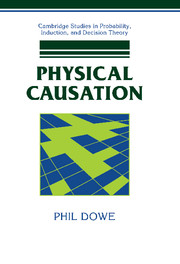Book contents
- Frontmatter
- Contents
- Acknowledgements
- 1 Horses for Courses: Causation and the Task of Philosophy
- 2 Hume's Legacy: Regularity, Counterfactual and Probabilistic Theories of Causation
- 3 Transference Theories of Causation
- 4 Process Theories of Causation
- 5 The Conserved Quantity Theory
- 6 Prevention and Omission
- 7 Connecting Causes and Effects
- 8 The Direction of Causation and Backwards-in-Time Causation
- References
- Index
5 - The Conserved Quantity Theory
Published online by Cambridge University Press: 13 October 2009
- Frontmatter
- Contents
- Acknowledgements
- 1 Horses for Courses: Causation and the Task of Philosophy
- 2 Hume's Legacy: Regularity, Counterfactual and Probabilistic Theories of Causation
- 3 Transference Theories of Causation
- 4 Process Theories of Causation
- 5 The Conserved Quantity Theory
- 6 Prevention and Omission
- 7 Connecting Causes and Effects
- 8 The Direction of Causation and Backwards-in-Time Causation
- References
- Index
Summary
It is profitable to distinguish three key questions about causation. The first question is what are causal processes and interactions? I follow Salmon in the view that it is advantageous to focus on this question rather than on more traditional questions about causation. As we have seen, the key task in addressing this question is to distinguish causal from pseudo processes. In this chapter I offer an account of causal processes and interactions that, I argue, adequately makes this distinction. I show how this account answers a range of objections, in comparison to other theories, in particular to Salmon's theory and his recent revisions.
The second question – what is the connection between causes and effects? – is not addressed in the present chapter. In Chapter 7, however, I discuss the kind of answer one can give to this second question if one accepts the results of the present chapter; and I defend that answer against its rivals. The third question is what distinguishes a cause from its effects? In Chapter 8 I discuss the kind of answer once can give to this if one accepts the results of the present chapter; and I defend that answer against its rivals. It is important to emphasise that the account of causal processes and interactions given in this chapter is not intended to address the second and third questions.
- Type
- Chapter
- Information
- Physical Causation , pp. 89 - 122Publisher: Cambridge University PressPrint publication year: 2000



